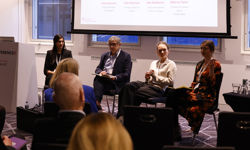Press briefings with Steve Forbes, editor-in-chief of Forbes and sometime US presidential candidate, wander far and wide. The nitty gritty of his latest European venture blended in with his musings on the financial crash (“it was government’s failure to update the rules of the road”), Republican presidential hopefuls (he rated Mitch Daniels but wasn’t sure he wanted the job), memories of Bill Clinton’s disastrous first speech at a Democrat convention (“the biggest applause came when he said “in conclusion””), the backlog at the US patent office, tackling the budget deficit (“the UK is way ahead of the US on this”), tax simplification, “Obamacare” and much much more. All fascinating stuff.
But, back at the coalface. What is Forbes up to in Europe? They have just launched Forbes in Europe, a twenty thousand print run English language European edition, mailed to C-level and senior executives across eleven countries and available in selected newsstands and the usual business lounges. They plan to increase the number of Europe based staffers from the current ten to nearer thirty in time.
Why? Business is increasingly global with supply chains stretching across continents. Witness one of the less remarked upon ramifications of the Japan earthquake, the fall in Apple stock due to the fact that some iPhone parts are sourced from Japan. Forbes purports to be a global player, so a European edition plugs a gap in their portfolio. As CEO Mike Perlis put it, “it was time to take the formula that has been so successful for us and extend our footprint into Europe.”
The other big development was the fusing of Forbes magazine and Forbes.com to form a social journalism environment where journalists, contributors and readers could come together in a shared space. Every contributor will have his own home page, resulting in a network of thousands of contributor pages within the site. Particularly insightful comment would then flow back into the magazine, and says Forbes chief revenue officer, Kevin Gentzel, C-level execs are “losing their inhibitions and starting to contribute”.
In response to questions over the croissants, the Forbes executives expanded on their publishing strategy.
Mike raised a few eyebrows, when he revealed that print, digital revenue splits are about fifty fifty, and put this down to Forbes’ original decision to create Forbes.com as a separate division and not as an ancillary to the print operation. While the two operations have since merged, this early separation allowed the web operation to forge its own strategy. Forbes.com has also, he said, managed to avoid the commoditisation of web ads by offering high value niches within their site, enabling them to charge premium rates to advertisers wishing to target, for instance, CIOs.
But what shone through was their deeply held belief in the enduring value of print. According to Kevin Gentzel, readership of the print magazine is at an all time high. Steve explained that “print allows you to deal with a story in a much more thorough way, whereas online allows you to amplify.”
Like everyone else in media, Forbes is constantly experimenting with new business models, but for the time being, seem wedded to the open access approach. When pushed on why they were not charging for their high value business information, as the FT does, Kevin explained that they believed in the “ad driven model, so scale is important”. Steve Forbes elaborated that the revenue from even a successful paywall operation would “not even come close to the ad revenues” their current free access model was generating.
And the question du jour, what about tablets? One questioner seemed genuinely surprised that we were sitting down in 2011 discussing a print launch at all! Especially since, he reasoned, tablet penetration amongst Forbes’ well healed target market must be high. Aside from the already mentioned belief in print, Mike Perlis said that Forbes.com already “suits up really well” on the iPad so didn’t see the immediate need for a dedicated app.
Steve Forbes said it was all too easy to get hung up on every new delivery channel; as long as you keep focussed on “what is your purpose”, then the various delivery options will slot into place.
The morning could have gone on and on, but after one and half hours, the nod was given and the Forbes cavalcade moved on – next stop Zurich.










